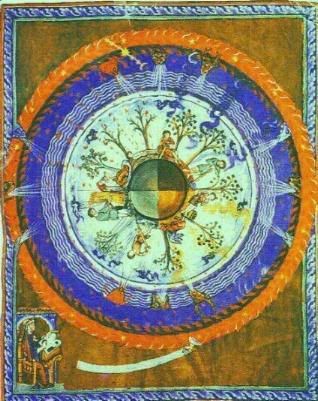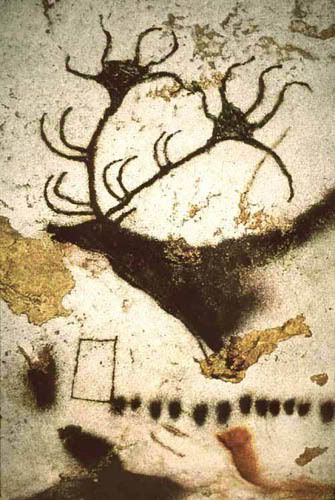Many of the features typical of deities and other supernatural entities depicted in various works of art throughout history, including brightness and radiance as well as gigantic proportions, distinctive coloration, elaborate costuming, etc. can be understood on a compositional level as illusionistic devices or visual story-telling techniques to draw attention and denote importance. This in no way lessens the likely veracity that many universal divine symbolic characteristics draw their origins from various hallucinatory experiences. At the heart of this matter is the relationship between psychotropic agents and priest class in general and esoteric, inner circles in particular.
One reason for this perhaps is that various psycho-reactive chemical agents cannot be said to be solely responsible for all supernatural experience because they are not responsible for all hallucinatory experience. Indeed, if we are operating healthily, we all engage in a major hallucinatory experience on a daily basis when we sleep, a completely altered state of consciousness, and as stated, one that's regular experience is necessary for healthy physical and cognitive function.
Dr. Oliver Sacks' updated edition of "Migraine" deals in part with duplicate characteristics and commonalties of various hallucinatory and other dissociative effects between migraine auras and other neurological events, hallucinogens, various sleep states, and the neurological activity the constitutes "normal" cognition. Dr. Sack's other works include the highly recommended "The Man Who Mistook His Wife for a Hat", "An Anthropologist On Mars" and "Awakenings". Note that the film version of Awakenings features Robin Williams as the Dr. Sacks based Dr. Sayer. Robin's lay the prettiest of eggs. "Awakenings" also stars Raging Bull Taxi Cab Driver Robert De Niro and Julie "Marge Simpson" Kavener.

The manifestation of migraine auras can include experiences described as visions, transports, or trance states of hysteric, psychotic, oneiric (relating to or suggestive of dreams) or hypnagogic (relating to the state of intermediate consciousness preceding sleep) nature. The cardinal characteristic perceptual experiences of migraine aura are scotomatous (visual), paraesthetic (tactile), and aphasic (effects of understanding or using language, expressive, receptive or combined aphasia). Aphasia is one of the "Three As" of neurological dissociations, the other two being apraxia, the inability to take action due to a disturbance of higher brain function preventing the synthesis of components of actions, and agnosia, the inability to perceive due to an inability to integrate perceptual components. On a strictly visual sense there is a marked relationship between the sensitivity of the optic nerve (to tactile pressure as well as photons, vascular activity, particularly increased blood pressure in one or both eyes, and the perception of phosphenes which experienced along with other perceptual distortions such as persistence of image (trails), may form the more complex geometric patterns experienced in altered states of consciousness (sleep and the borderlands of sleep).
Beyond this, numerous case studies of patients under the care of Dr. Sacks and others demonstrates that sensations experienced during incidents of migraine aura of a more emotional or abstract psychological nature correspond to the qualities of mystical experience as described by William James in his 1902 publication "The Varieties of Religious Experience". As described by James the cardinal characteristics of mystical experience are ineffability (a sensation of experience beyond description), noetic quality (revealing information beyond normal human conception), transiency (the experience is brief and imperfectly remembered), and passivity (the individual experiences a state of being taken over by a separate or higher entity(ies) or intelligence(s)). A very clear example of the potential relationship between migraine aura hallucinations and mystic experience are the Visions of Hildegard of Bingen.


It is believed that the reason tryptamines and other chemical compounds cause various hallucinatory and other dissociative states is because they duplicate or otherwise mimic neurotransmitters and other hormones in the body or block or otherwise alter the regular action of neurotransmitters. All the perceptual qualities they seemingly create, like all perceptions and acts of cognition, can not be separated from natural neuro-physiological function. The states of consciousness are inherent and certain external and internal agents can stimulate their action.
All of this together brings to my attention the need to investigate the interrelationships of art, tool development, religious conceptions, and the evolution of hominid psychological conceptions in general. Certainly it can be safely postulated that experience of various altered states of consciousness, natural or generated through ingestion or other acts partaken for the purpose of generating "trance" states, including sensory deprivation, starvation, dehydration, sleep deprivation, pain generation, etc. and various combinations, played a major role in early developments in all of these and other areas. That the use of various psychotropic agents by mammals (and other animal species) predates human development is demonstratable through anecdote alone. I've read accounts of squirrels being observed hoarding fly agaric mushrooms. In case anyone was curious about it, part of the suggested relationship between Santa Claus and fly agaric comes from the fact that the hallucinogenic property is not altered through digestion, unlike other toxins in the mushroom that cause negative side effects such as nausea. Apparently reindeers naturally seek out fly agaric, and if one is to let them eat the mushrooms and then collect their urine, one may experience the trip without physical impairment. See Tom Volk's Fungus of the Month for December 1999.

A great deal of insightful general information regarding the development of hominid religion, art, tools and psychology can be found at Dr. James B. Harrod's Origins Net: Origins of Art, Religion and Mind. Among the many interesting facts presented is the apparent development of the first metaphor, the concept of a "core" of being capable of refinement, in the Oldowan period c. 2.6 - 1.6 million years ago by Homo rudofensis/habilis. Perhaps more immediately pertinent to the conversation at hand are examples of art from the Upper Paleolithic period (60,000 to 10,000 years ago) depicting geometric patterns, phosphenes, and other expressions of trance experience from naturally occurring or purposeful hallucinatory states. The "Venus" and other anthropomorphic figures of this time period are frequently found in shamanic trance postures, suggesting practices of male and female ritualized "spiritual" transformation processes, the purpose of which at least in part being the triggering of naturally occurring altered states of consciousness.

Harrod comments "From the Nairobi area, circa 2 million years ago. This is a photograph of cast of the original. Archaeologist at Koobi Fora believe the rhomboid diamond shape, which is unique in the collection, was an accidental byproduct of flaking the core for useable flake. This core was a 'curated' object, carried into the site. I believe this core with its rhomboid diamond shape may be interpreted as exemplary for understanding the Oldowan mind and Oldowan spirituality".

"Lascaux. (c. 16,000 BC). Thirteen dots may indicate thirteen months in a lunar year, or coincidental. Additional series of about twenty-six dots under horse to the left of this image".
It is suggested by Harrod, and others, that the animals depicted in paintings and carvings are of a complexity capable of representing a form of iconographic system with juxtapositions, pairings and multiple levels of signification, with the capacity of encoding an encyclopedia of cultural knowledge, including zoological, social, economic, psychological information, and basic themes of morality. This could be seen as broadening the potential effects of hallucinatory experience on essential factors of human society beyond religious expression, including artistic/aesthetic concerns, tool development, proto-language development, etc., etc. I think it is striking that there is a very natural and very early relationship between operative stone masonry and religious symbolism.
Another important factor in social development with a major impact on theological conceptions and organizations is astronomy. That relatively sophisticated astronomical observation was taking place very early is evidenced through lunar calendars and other notation systems dating to the Upper Paleolithic era and earlier. That many basic religious symbols, figures, and characters, including the cross, derive their origins from astronomical observations is a major area in its own right.
I am particularly struck by the relationship between the pineal gland and the production and regulation of hormones and neurotransmitters, and information or stimulation of that gland by solar or other photon sources. Light is seemingly the defining principle of reality, and there are no points of existence, physical or otherwise, that can be removed from dependency on solar activity. Systems of solar worship are often considered to be naïve expressions of the human tendency to anthropomorphize non-human features of nature. In fact the observation that the sun in the sky is the creator and the provider of all things, including "soul" or "mind" can be seen as a rather sophisticated scientific observation, expressed in a poetic/allegorical technical language that through corruption of oral tradition, repeated translation and numerous other factors developed into what we conceive of today as the basis of metaphysical belief systems.
No comments:
Post a Comment